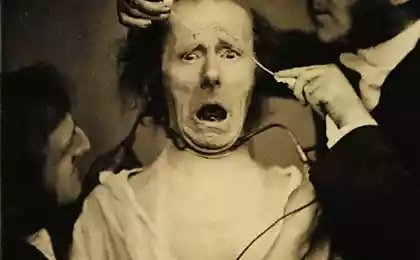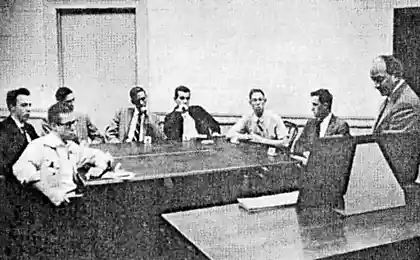268
Milgram's experiment half a century later
Half a century ago, Stanley Milgram conducted a legendary experiment that showed how easily ordinary people, obeying orders, do terrible things. And newly discovered archival evidence points to what motivates this willingness: the belief that cruelty serves a good purpose.
In 1961, Adolf Eichmann, the direct leader of the mass extermination of Jews in Nazi Germany, was tried in Jerusalem. The process was important not only because the criminal was overtaken by deserved retribution, but also the huge influence he had on the development of modern ideas about human social behavior. The strongest impression on those who watched the course of the trial was made by the line of defense chosen by Eichmann, who rested on the fact that, in running the conveyor of death, he was only doing his job, obeying the orders and requirements of the laws. And this is very similar to the truth: the defendant did not give the impression of a monster, a sadist, a manic anti-Semite or a pathological personality. He was incredibly, terribly normal.
The trial of Eichmann and a detailed analysis of the psychological and social mechanisms that cause normal people to commit terrible atrocities is devoted to the classic moral philosophy book Hannah Arendt, covering the trial for The New Yorker, The Banality of Evil. Eichmann in Jerusalem (Europe, 2008).
“Experience must be brought to the end.” Another, no less famous study of the banality of evil was conducted by Yale psychologist Stanley Milgram, who proved experimentally: indeed, the most ordinary people, as a rule, are so inclined to submit to a figure endowed with power that, “only” following an order, they are capable of extreme cruelty towards other people, to whom neither malice nor hatred harbour. The Obedience Experiment, better known simply as the Milgram Experiment, was started a few months after Eichmann’s trial began and was influenced by him, and the first work on his results came out in 1963.
The experiment was designed this way. It was presented to participants as a study of the effect of pain on memory. The experiment involved an experimenter, a subject (“teacher”) and an actor who played the role of another subject (“student”). It was stated that the “student” should memorize pairs of words from a long list, and the “teacher” should test his memory and punish each mistake with an increasingly strong electrical discharge. Before the start of the action, the “teacher” received a demonstration blow of 45 V. He was also assured that electric shocks would not cause serious harm to the health of the “student”. Then the “teacher” went to another room, began to give the “student” tasks and at each mistake pressed the button, allegedly giving an electric shock (in fact, the actor who played the “student” only pretended that he was getting hits). Starting with 45 V, the “teacher” with each new error had to increase the voltage by 15 V up to 450 V.
If the "teacher" hesitated before giving another "discharge", the experimenter assured him that he took full responsibility for what was happening and said: "Continue, please." The experience must be brought to the end. You have to do it, you have no choice.” At the same time, however, he did not threaten the doubting “teacher”, including the deprivation of remuneration for participation in the experiment ($ 4).
In the first version of the experiment, the room in which the student was located was isolated, and the teacher could not hear him. It was only when the force of the "blow" reached 300 volts (all 40 subjects had reached this point, and none had stopped before!), that the "student" actor began to beat against the wall, and this is what the "teacher" heard. Soon, the student stopped answering questions.
26 people reached the very end. They continued to press the button even when the voltage reached 450 V. On the scale of their "device" values from 375 to 420 V were marked with the inscription "Dangerous: severe shock", and marks 435 and 450 V - just the sign "XXX".
Of course, the experiment was repeated many times, checked and rechecked, slightly varying the conditions (gender composition of the participants, the degree of pressure from the experimenter, the behavior of the actor-"student"). In one version, in particular, when the force of the “blow” reached 150 V, the “student” began to complain about the heart and asked to stop, and the “teacher” heard him. After that, 7 out of 40 people refused to increase the “voltage” beyond the 150-volt mark, but to the end – to 450 V – reached, oddly enough, the same 26 out of 40.
45 years later
The impact of Milgram’s experiment on the professional community has been so great that codes of ethics have now been developed, making it impossible to reconstruct it completely.
But in 2008, Jerry Burger of Santa Clara University in the U.S. replicated Milgram’s experiment, modifying its conditions to accommodate existing limitations. In Berger’s experiments, the “voltage” increased only to 150 volts (although the marking went up to the same 450 V on the “device” scale), after which the experiment was interrupted. At the selection stage, participants were screened out: first, those who knew about the Milgram experiment, and second, emotionally unstable people. Each of the test subjects was repeated at least three times that they can interrupt the experience at any stage, and the reward ($50) will not have to be returned. The strength of the demonstration (real) shock, which was received by the subjects before the experiment, was 15 V.
As it turned out, in 25 years, not much has changed: 28 of the 40 subjects (that is, 70%) were ready to continue to increase tension and after the “student”, allegedly receiving a 150-volt stroke, complained about the heart.
And now, thanks to archival materials analyzed by social psychologists from four universities in Australia, Scotland and the United States, it is found that in the initial experiment, things were actually even worse than we used to think.
The fact is that from reading the works that Milgram himself published, it seems that obeying the orders of the participants in the experiment was difficult and unpleasant, or even painful. “I saw a solid businessman enter the laboratory smiling and confident. In 20 minutes he was brought to a nervous breakdown. He was shaking, stuttering, constantly pulling his earlobe and wringing his hands. One time he punched himself in the forehead and muttered, "Oh my God, let's stop this." Nevertheless, he continued to respond to every word of the experimenter and obeyed him unconditionally.
But studying the feedback notes given by the subjects after the experiment was completed and their eyes were opened, explaining the true essence of what happened, says something else. In the archives of Yale University, such references are available regarding the impressions of 659 of the 800 volunteers who participated in various “doubles” of the experiment. Most of these people – ordinary, normal people, not sadists or maniacs – showed no sign of remorse. On the contrary, they reported that they were happy to help science.
“This sheds new light on the psychology of submission and is consistent with other available evidence that people who do evil are usually driven not by the desire to do evil, but by the belief that they are doing something worthy and noble,” said one of the authors of the archival study, Professor Alex Haslam. He is echoed by his colleague Professor Stephen Reicher: One might assume that we have misunderstood the ethical and theoretical problems posed by Milgram’s research. One should ask oneself whether one should care about the well-being of the participants in the experiments, making them think that inflicting suffering on others can be justified if it was done for a good purpose.
The study also involved Australian documentary filmmaker, professor at Macquarie University in Sydney Katherine Millard (Kathryn Millard). The materials found in the archives, she used in her new film “Shock Room”, which is now coming to the screens. The film explores how and why people obey criminal orders and, equally important, how and why some refuse to do evil.
It’s time to ask yourself again, “What would I do?”
S. Milgram, “Behavioural Study of Obedience: Journal of Abnormal and Social Psychology”, 1963, vol. 67, no. 4.
J. Burger, "Replicating Milgram: Would People Still Obey Today?", American Psychologist, January 2009.
*** S. Haslam et al. “Happy to have been of service”: The Yale archive as a window into the engaged followership of participants in Milgram's “obedience” experiments. British Journal of Social Psychology, September 2014.
Source:psychologies.ru
Source: /users/1077
In 1961, Adolf Eichmann, the direct leader of the mass extermination of Jews in Nazi Germany, was tried in Jerusalem. The process was important not only because the criminal was overtaken by deserved retribution, but also the huge influence he had on the development of modern ideas about human social behavior. The strongest impression on those who watched the course of the trial was made by the line of defense chosen by Eichmann, who rested on the fact that, in running the conveyor of death, he was only doing his job, obeying the orders and requirements of the laws. And this is very similar to the truth: the defendant did not give the impression of a monster, a sadist, a manic anti-Semite or a pathological personality. He was incredibly, terribly normal.
The trial of Eichmann and a detailed analysis of the psychological and social mechanisms that cause normal people to commit terrible atrocities is devoted to the classic moral philosophy book Hannah Arendt, covering the trial for The New Yorker, The Banality of Evil. Eichmann in Jerusalem (Europe, 2008).
“Experience must be brought to the end.” Another, no less famous study of the banality of evil was conducted by Yale psychologist Stanley Milgram, who proved experimentally: indeed, the most ordinary people, as a rule, are so inclined to submit to a figure endowed with power that, “only” following an order, they are capable of extreme cruelty towards other people, to whom neither malice nor hatred harbour. The Obedience Experiment, better known simply as the Milgram Experiment, was started a few months after Eichmann’s trial began and was influenced by him, and the first work on his results came out in 1963.
The experiment was designed this way. It was presented to participants as a study of the effect of pain on memory. The experiment involved an experimenter, a subject (“teacher”) and an actor who played the role of another subject (“student”). It was stated that the “student” should memorize pairs of words from a long list, and the “teacher” should test his memory and punish each mistake with an increasingly strong electrical discharge. Before the start of the action, the “teacher” received a demonstration blow of 45 V. He was also assured that electric shocks would not cause serious harm to the health of the “student”. Then the “teacher” went to another room, began to give the “student” tasks and at each mistake pressed the button, allegedly giving an electric shock (in fact, the actor who played the “student” only pretended that he was getting hits). Starting with 45 V, the “teacher” with each new error had to increase the voltage by 15 V up to 450 V.
If the "teacher" hesitated before giving another "discharge", the experimenter assured him that he took full responsibility for what was happening and said: "Continue, please." The experience must be brought to the end. You have to do it, you have no choice.” At the same time, however, he did not threaten the doubting “teacher”, including the deprivation of remuneration for participation in the experiment ($ 4).
In the first version of the experiment, the room in which the student was located was isolated, and the teacher could not hear him. It was only when the force of the "blow" reached 300 volts (all 40 subjects had reached this point, and none had stopped before!), that the "student" actor began to beat against the wall, and this is what the "teacher" heard. Soon, the student stopped answering questions.
26 people reached the very end. They continued to press the button even when the voltage reached 450 V. On the scale of their "device" values from 375 to 420 V were marked with the inscription "Dangerous: severe shock", and marks 435 and 450 V - just the sign "XXX".
Of course, the experiment was repeated many times, checked and rechecked, slightly varying the conditions (gender composition of the participants, the degree of pressure from the experimenter, the behavior of the actor-"student"). In one version, in particular, when the force of the “blow” reached 150 V, the “student” began to complain about the heart and asked to stop, and the “teacher” heard him. After that, 7 out of 40 people refused to increase the “voltage” beyond the 150-volt mark, but to the end – to 450 V – reached, oddly enough, the same 26 out of 40.
45 years later
The impact of Milgram’s experiment on the professional community has been so great that codes of ethics have now been developed, making it impossible to reconstruct it completely.
But in 2008, Jerry Burger of Santa Clara University in the U.S. replicated Milgram’s experiment, modifying its conditions to accommodate existing limitations. In Berger’s experiments, the “voltage” increased only to 150 volts (although the marking went up to the same 450 V on the “device” scale), after which the experiment was interrupted. At the selection stage, participants were screened out: first, those who knew about the Milgram experiment, and second, emotionally unstable people. Each of the test subjects was repeated at least three times that they can interrupt the experience at any stage, and the reward ($50) will not have to be returned. The strength of the demonstration (real) shock, which was received by the subjects before the experiment, was 15 V.
As it turned out, in 25 years, not much has changed: 28 of the 40 subjects (that is, 70%) were ready to continue to increase tension and after the “student”, allegedly receiving a 150-volt stroke, complained about the heart.
And now, thanks to archival materials analyzed by social psychologists from four universities in Australia, Scotland and the United States, it is found that in the initial experiment, things were actually even worse than we used to think.
The fact is that from reading the works that Milgram himself published, it seems that obeying the orders of the participants in the experiment was difficult and unpleasant, or even painful. “I saw a solid businessman enter the laboratory smiling and confident. In 20 minutes he was brought to a nervous breakdown. He was shaking, stuttering, constantly pulling his earlobe and wringing his hands. One time he punched himself in the forehead and muttered, "Oh my God, let's stop this." Nevertheless, he continued to respond to every word of the experimenter and obeyed him unconditionally.
But studying the feedback notes given by the subjects after the experiment was completed and their eyes were opened, explaining the true essence of what happened, says something else. In the archives of Yale University, such references are available regarding the impressions of 659 of the 800 volunteers who participated in various “doubles” of the experiment. Most of these people – ordinary, normal people, not sadists or maniacs – showed no sign of remorse. On the contrary, they reported that they were happy to help science.
“This sheds new light on the psychology of submission and is consistent with other available evidence that people who do evil are usually driven not by the desire to do evil, but by the belief that they are doing something worthy and noble,” said one of the authors of the archival study, Professor Alex Haslam. He is echoed by his colleague Professor Stephen Reicher: One might assume that we have misunderstood the ethical and theoretical problems posed by Milgram’s research. One should ask oneself whether one should care about the well-being of the participants in the experiments, making them think that inflicting suffering on others can be justified if it was done for a good purpose.
The study also involved Australian documentary filmmaker, professor at Macquarie University in Sydney Katherine Millard (Kathryn Millard). The materials found in the archives, she used in her new film “Shock Room”, which is now coming to the screens. The film explores how and why people obey criminal orders and, equally important, how and why some refuse to do evil.
It’s time to ask yourself again, “What would I do?”
S. Milgram, “Behavioural Study of Obedience: Journal of Abnormal and Social Psychology”, 1963, vol. 67, no. 4.
J. Burger, "Replicating Milgram: Would People Still Obey Today?", American Psychologist, January 2009.
*** S. Haslam et al. “Happy to have been of service”: The Yale archive as a window into the engaged followership of participants in Milgram's “obedience” experiments. British Journal of Social Psychology, September 2014.
Source:psychologies.ru
Source: /users/1077























